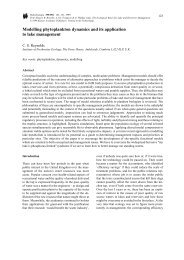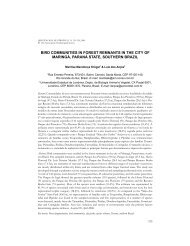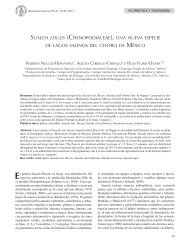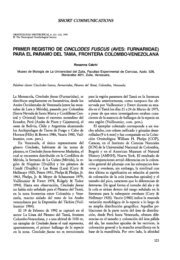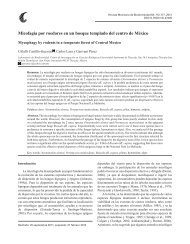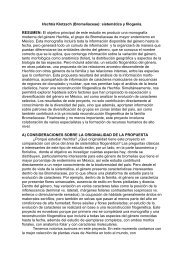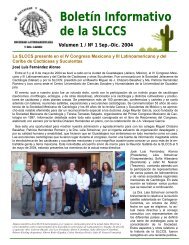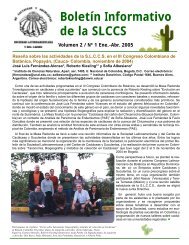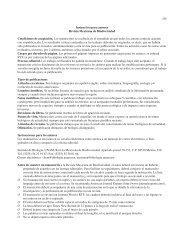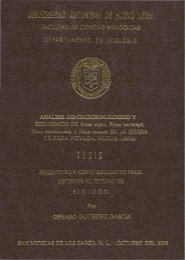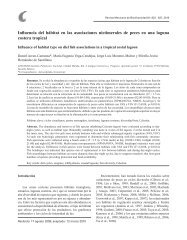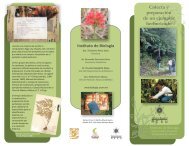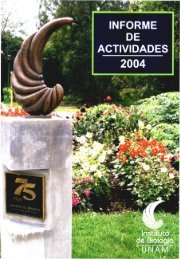Cestodes of the family Dilepididae - Instituto de Biología - UNAM
Cestodes of the family Dilepididae - Instituto de Biología - UNAM
Cestodes of the family Dilepididae - Instituto de Biología - UNAM
Create successful ePaper yourself
Turn your PDF publications into a flip-book with our unique Google optimized e-Paper software.
Systematic Parasitology 52: 171–182, 2002.<br />
© 2002 Kluwer Aca<strong>de</strong>mic Publishers. Printed in <strong>the</strong> Ne<strong>the</strong>rlands.<br />
<strong>Cesto<strong>de</strong>s</strong> <strong>of</strong> <strong>the</strong> <strong>family</strong> <strong>Dilepididae</strong> (Cestoda: Cyclophylli<strong>de</strong>a) from<br />
fish-eating birds in Mexico: a survey <strong>of</strong> species<br />
Tomáš Scholz1,2 , Roman Kuchta3 & Guillermo Salgado-Maldonado4 1Institute <strong>of</strong> Parasitology, Aca<strong>de</strong>my <strong>of</strong> Sciences <strong>of</strong> <strong>the</strong> Czech Republic, Branišovská 31, 370 05 České Budějovice,<br />
Czech Republic (Address for correspon<strong>de</strong>nce)<br />
2Laboratory <strong>of</strong> Parasitology, Centre for Investigation and Advanced Studies <strong>of</strong> <strong>the</strong> National Polytechnic Institute<br />
(CINVESTAV-IPN) Mérida Unit, A.P. 73 “Cor<strong>de</strong>mex”, C.P. 97310 Mérida, Yucatán, Mexico<br />
3Faculty <strong>of</strong> Biological Sciences, University <strong>of</strong> South Bohemia, Branišovská 31, 370 05 České Budějovice, Czech<br />
Republic<br />
4Institute <strong>of</strong> Biology, National Autonomous University <strong>of</strong> Mexico (<strong>UNAM</strong>), A.P. 53-173, C.P. 04510 México, D.F.,<br />
Mexico<br />
Accepted for publication 6th November, 2001<br />
Abstract<br />
A survey <strong>of</strong> adults <strong>of</strong> dilepidid tapeworms (Cyclophylli<strong>de</strong>a) from piscivorous birds from Mexico is presented<br />
on <strong>the</strong> basis <strong>of</strong> <strong>the</strong> taxonomic evaluation <strong>of</strong> freshly collected and voucher specimens. The following species are<br />
reported (first records from Mexico marked with an asterisk): Cyclustera capito (Rudolphi, 1819); ∗ C. ibisae<br />
(Schmidt & Bush, 1972); ∗ Dendrouterina ar<strong>de</strong>ae Rausch, 1955; ∗ D. herodiae Fuhrmann, 1912; ∗ D. papillifera<br />
(Fuhrmann, 1908); Glossocercus auritus (Rudolphi, 1819); ∗ Neogryporhynchus cheilancristrotus (Wedl, 1855);<br />
Paradilepis caballeroi Rysavy & Macko, 1973; Paradilepis sp.; Parvitaenia cochlearii Coil, 1955; and Valipora<br />
mutabilis Linton, 1927. Dendrouteria herodiae is reported from America for <strong>the</strong> first time. New <strong>de</strong>finitive hosts<br />
are Phalacrocorax olivaceus for C. capito, N. cheilancristrotus and P. caballeroi; Casmerodius albus and Egretta<br />
thula for G. auritus; andE. thula for D. herodiae. Data on <strong>the</strong> morphology <strong>of</strong> <strong>the</strong> rostellar hooks <strong>of</strong> all species,<br />
<strong>the</strong>ir hosts and distribution in Mexico are provi<strong>de</strong>d.<br />
Introduction<br />
Tapeworms <strong>of</strong> <strong>the</strong> <strong>family</strong> <strong>Dilepididae</strong> Railliet &<br />
Henry, 1909 (Eucestoda: Cyclophylli<strong>de</strong>a) are frequent<br />
and wi<strong>de</strong>ly distributed parasites <strong>of</strong> birds, with many<br />
species parasitising fish-eating birds, such herons,<br />
spoonbills and cormorants (Bona, 1994). The taxonomy<br />
<strong>of</strong> <strong>the</strong> group has been treated in <strong>de</strong>tail by Bona<br />
(1975, 1994), but <strong>the</strong> information on <strong>the</strong> occurrence <strong>of</strong><br />
dilepidid cesto<strong>de</strong>s, <strong>the</strong>ir species composition and distribution<br />
in Latin America is ra<strong>the</strong>r limited (see Bona,<br />
1975, 1983a,b).<br />
This is also valid for Mexico, from where only<br />
three records <strong>of</strong> adult dilepidids have been published.<br />
Coil (1955a) reported adults <strong>of</strong> Cyclustera<br />
capito (Rudolphi, 1819) from <strong>the</strong> roseate spoonbill<br />
Platalea ajaja L. from Oaxaca, and <strong>the</strong> same author<br />
(Coil 1955b) <strong>de</strong>scribed Parvitaenia cochlearii<br />
171<br />
from <strong>the</strong> boat-billed heron Cochlearius cochlearius<br />
(L.) from both Oaxaca and Chiapas. More recently,<br />
Lamo<strong>the</strong>-Argumedo et al. (1997) listed four species<br />
<strong>of</strong> dilepidids found in Mexico; namely, Dendrouterina<br />
botauri Rausch, 1948 from Egretta thula (Molina),<br />
Dilepis hilli Polk, 1941 from Bubulcus ibis (L.), and<br />
Ophiovalipora minuta (Coil, 1950) and O. nycticoracis<br />
(Olsen, 1936) from Nycticorax nycticorax (L.).<br />
However, no data on <strong>the</strong> morphology <strong>of</strong> <strong>the</strong>se species<br />
have been provi<strong>de</strong>d.<br />
Scholz & Salgado-Maldonado (2001) have recently<br />
found metacesto<strong>de</strong>s <strong>of</strong> as many as 13 species<br />
<strong>of</strong> dilepidid tapeworms in fishes from Mexico, which<br />
indicates that cesto<strong>de</strong>s <strong>of</strong> this <strong>family</strong> may be relatively<br />
frequent parasites. During studies on <strong>the</strong> helminth<br />
parasites <strong>of</strong> piscivorous birds from central and sou<strong>the</strong>astern<br />
Mexico, several species <strong>of</strong> dilepidid cesto<strong>de</strong>s
172<br />
were found, with most tapeworms being reported as<br />
adults from Mexico for <strong>the</strong> first time.<br />
During <strong>the</strong> evaluation <strong>of</strong> this material, all vouchers<br />
<strong>of</strong> dilepidids found in Mexico and <strong>de</strong>posited in<br />
<strong>the</strong> National Helminthological Collection <strong>of</strong> Mexico<br />
(CNHE), <strong>Instituto</strong> <strong>de</strong> <strong>Biología</strong>, Universidad Nacional<br />
Autónoma <strong>de</strong> México, Mexico City, were also examined<br />
and numerous misi<strong>de</strong>ntifications were found.<br />
Therefore, all available material <strong>of</strong> dilepidid tapeworms<br />
parasitising fish-eating birds in Mexico has<br />
been revised and a survey <strong>of</strong> species is presented,<br />
toge<strong>the</strong>r with <strong>the</strong> information on <strong>the</strong> spectrum <strong>of</strong><br />
<strong>the</strong>ir <strong>de</strong>finitive hosts, geographical distribution and<br />
life-cycles.<br />
Materials and methods<br />
The specimens studied were found in fish-eating birds<br />
from several localities in central and sou<strong>the</strong>astern<br />
Mexico (see ‘Survey <strong>of</strong> species’). Freshly collected<br />
specimens were fixed with 4% formal<strong>de</strong>hy<strong>de</strong> solution,<br />
ei<strong>the</strong>r un<strong>de</strong>r pressure or with hot (almost boiling)<br />
fixative. Scoleces <strong>of</strong> some specimens were squashed<br />
to place <strong>the</strong> rostellar hooks into one layer and <strong>the</strong>n<br />
fixed with glycerine-ammonium picrate, using <strong>the</strong><br />
methodology outlined by Ergens (1969). The following<br />
voucher specimens from <strong>the</strong> National Helminthological<br />
Collection <strong>of</strong> Mexico have been examined:<br />
Dendrouterina botauri Rausch, 1948 (CNHE Collection<br />
No. 1314); Dilepis hilli Polk, 1941 (CNHE 393);<br />
Ophiovalipora minuta Coil, 1950 (CNHE 392); and O.<br />
nycticoracis (Olsen, 1937) (CNHE 1315). The types<br />
(holotype and paratypes) <strong>of</strong> Glossocercus caribaensis<br />
(Rysavy & Macko, 1973) from <strong>the</strong> helminthological<br />
collection <strong>of</strong> <strong>the</strong> Parasitological Institute, Slovak<br />
Aca<strong>de</strong>my <strong>of</strong> Sciences, Košice (PISAS 9673a,b,c,e),<br />
9 type-specimens (8 specimens labelled as ‘syntypes’<br />
and one as ‘paratype’) <strong>of</strong> Paradilepis brevis Burt,<br />
1940 and vouchers <strong>of</strong> Paradilepis scolecina (Rudolphi,<br />
1819) from The Natural History Museum, London,<br />
UK (BMNH 1983.7.19.13-17 and 1946.5.6.41-<br />
55, respectively), and vouchers <strong>of</strong> P. scolecina from<br />
<strong>the</strong> helminthological collection <strong>of</strong> <strong>the</strong> Institute <strong>of</strong> Parasitology,<br />
Aca<strong>de</strong>my <strong>of</strong> Sciences <strong>of</strong> <strong>the</strong> Czech Republic,<br />
České Budějovice (IPCAS C-168) were also studied.<br />
As most species were re<strong>de</strong>scribed by Bona (1975),<br />
morphological <strong>de</strong>scriptions <strong>of</strong> <strong>the</strong> Mexican material<br />
are largely limited to data on <strong>the</strong> rostellar hooks. Measurements<br />
in <strong>de</strong>scriptions are in micrometres (µm) unless<br />
o<strong>the</strong>rwise stated. The specimens are <strong>de</strong>posited in<br />
<strong>the</strong> National Helminthological Collection <strong>of</strong> Mexico<br />
(CNHE); US National Parasite Collection (USNPC),<br />
Beltsville, Maryland, USA; Institute <strong>of</strong> Parasitology,<br />
Aca<strong>de</strong>my <strong>of</strong> Sciences <strong>of</strong> <strong>the</strong> Czech Republic, České<br />
Budějovice (IPCAS); and The Natural History Museum,<br />
London, UK (BMNH). The classification proposed<br />
by Bona (1975, 1994) is followed in this paper<br />
and <strong>the</strong> nomenclature <strong>of</strong> bird species follows that <strong>of</strong><br />
<strong>de</strong>l Hoyo et al. (1992). Species being reported from<br />
Mexico for <strong>the</strong> first time are marked with an asterisk.<br />
Survey <strong>of</strong> species<br />
Cyclustera capito (Rudolphi, 1819) Fuhrmann,<br />
1901 (Figure 1A)<br />
Host and locality: Phalacrocorax olivaceus (Humboldt)<br />
– State <strong>of</strong> Yucatán: Chelém lagoon at Chuburná<br />
(January, 1994).<br />
Site: Intestine.<br />
Specimens <strong>de</strong>posited: IPCAS C-278.<br />
Comments: The specimens found were in bad condition,<br />
which ma<strong>de</strong> it impossible to obtain <strong>de</strong>tailed data<br />
on <strong>the</strong>ir strobilar morphology. However, <strong>the</strong> shape and<br />
size <strong>of</strong> <strong>the</strong> hooks (Table 1; compare Figure 1A with<br />
plate 67, figure Aa in Bona, 1975) and <strong>the</strong> internal<br />
morphology, such as <strong>the</strong> regularly alternating genital<br />
pores, <strong>the</strong> distribution (surrounding <strong>the</strong> seminal receptacle)<br />
and number (about 50) <strong>of</strong> testes, <strong>the</strong> dilation <strong>of</strong><br />
<strong>the</strong> vagina in premature proglottids, <strong>the</strong> shape <strong>of</strong> thickwalled<br />
cirrus-sac, and <strong>the</strong> presence <strong>of</strong> cyclusteroid<br />
rostellar apparatus with a very large pouch, are i<strong>de</strong>ntical<br />
to those typical <strong>of</strong> Cyclustera capito (see Bona,<br />
1975, 1994).<br />
This species was re<strong>de</strong>scribed by Coil (1955a) and<br />
Bona (1975). The former author found adults <strong>of</strong><br />
C. capito in <strong>the</strong> roseate spoonbill Platalea ajaja from<br />
Tututepec, Oaxaca, Mexico, and reported <strong>the</strong> hooks<br />
being 213–250 (distal) and 147–169 (proximal) in<br />
length. The tapeworms from Yucatán have distal hooks<br />
<strong>of</strong> a similar size (length 218–234; Table 1) to those<br />
re<strong>de</strong>scribed by Coil (1955a), but <strong>the</strong> proximal hooks<br />
are longer (173–186). Bona (1975) found <strong>the</strong> hooks<br />
to be 218–227 (distal) and 169–178 (proximal) long,<br />
whilst Rysavy & Macko (1973) recor<strong>de</strong>d <strong>the</strong>m as 224–<br />
233 and 167–180 long; both <strong>of</strong> <strong>the</strong>se correspond more<br />
closely to <strong>the</strong> present material.<br />
Adults <strong>of</strong> C. capito have been found in P. ajaja and<br />
Eudocimus albus (L.) from South America and North<br />
America, including Mexico and Cuba (Coil, 1955a;
Figure 1. Rostellar hooks <strong>of</strong> adults <strong>of</strong> dilepidid cesto<strong>de</strong>s from Mexico (distal hooks on <strong>the</strong> left). A. Cyclustera capito (Rudolphi, 1819);<br />
B. C. ibisae (Schmidt & Bush, 1972); C. Dendrouterina ar<strong>de</strong>ae (Rausch, 1955) (two distal hooks on <strong>the</strong> left); D. Dendrouterina herodiae<br />
Fuhrmann, 1912 (CNHE 1314); E. Dendrouterina papillifera (Fuhrmann, 1908) (CNHE 393); F. Glossocercus auritus (Rudolphi, 1819); G.<br />
Neogryporhynchus cheilancristrotus (Wedl, 1855); H. Paradilepis caballeroi Rysavy & Macko, 1973; I. Paradilepis sp. (proximal hook in <strong>the</strong><br />
middle); J, K. Valipora mutabilis Linton, 1927 (J, CNHE 392; K, CNHE 1315).<br />
173
174<br />
Table 1. Measurements <strong>of</strong> rostellar hooks <strong>of</strong> species <strong>of</strong> <strong>the</strong> <strong>Dilepididae</strong> from fish-eating birds in Mexico (range with mean ±<br />
standard <strong>de</strong>viation).<br />
Cyclustera capito<br />
(n=17)<br />
Distal hooks 218–234<br />
228 ± 4.7<br />
Bla<strong>de</strong> 128–134<br />
131 ± 2.8<br />
Handle 122–141<br />
128 ± 5.1<br />
Cyclustera ibisae<br />
(n=15)<br />
227–243<br />
233 ± 5.5<br />
160–176<br />
168 ± 6.4<br />
77–96<br />
88 ± 6.3<br />
Dendrouterina<br />
ar<strong>de</strong>ae<br />
(n=4)<br />
45–48<br />
47<br />
19–21.5<br />
20<br />
34–37<br />
35<br />
Dendrouterina<br />
herodiae<br />
(n=6)<br />
38–40<br />
39<br />
15–21.5<br />
17<br />
21.5–28<br />
26<br />
Dendrouterina<br />
papillifera<br />
(n =2)<br />
41–42<br />
21–22<br />
24–25<br />
Ratio 0.9–1.1 1.7–2.2 0.5–0.6 0.5–1.0 0.9<br />
Proximal hooks 173–186<br />
179–198<br />
44–45<br />
25–30<br />
26–27<br />
179 ± 4.3 190 ± 6.4 44<br />
27<br />
Bla<strong>de</strong> 83–106<br />
128–141<br />
18–21.5<br />
9–11<br />
12<br />
95 ± 5.9 135 ± 5.2 19.5<br />
10<br />
Handle 99–112<br />
70–86<br />
32–33<br />
15–18<br />
17<br />
105 ± 3.9<br />
80 ± 4.6 32<br />
16.5<br />
Ratio 0.8–1.0 1.6–1.8 0.6–0.7 0.5–0.7 0.7<br />
Glossocercus<br />
auritus<br />
(n=34)<br />
Distal hooks 237–285<br />
260 ± 11<br />
Bla<strong>de</strong> 160–195<br />
182 ± 9.5<br />
Handle 102–160<br />
118 ± 12.5<br />
Neogryporhynchus<br />
cheilancristrotus<br />
(n=7)<br />
65–75<br />
71.5<br />
38–44<br />
41<br />
35–38<br />
37<br />
Paradilepis<br />
caballeroi<br />
(n=42)<br />
98–119<br />
113 ± 5<br />
52–59<br />
55.5 ± 2<br />
43–67<br />
58 ± 5<br />
Paradilepis sp.<br />
(n=12)<br />
95–101<br />
98 ± 1.8<br />
36–39<br />
38 ± 1.2<br />
59–67<br />
63 ± 2.5<br />
Valipora<br />
mutabilis<br />
(n=10)<br />
27–31<br />
29<br />
11–15<br />
13<br />
15–19<br />
17<br />
Ratio 0.6–0.9 0.9–1.0 0.85–1.2 0.6 0.6–0.8<br />
Proximal hooks 160–224<br />
193 ± 15<br />
Bla<strong>de</strong> 115–138<br />
125 ± 6<br />
Handle 74–120<br />
93 ± 5<br />
39–44<br />
41<br />
21.5–24<br />
23<br />
20–24<br />
22<br />
75–88<br />
82 ± 3<br />
35–41<br />
39 ± 1.3<br />
37–52<br />
44 ± 3.1<br />
65–71<br />
69 ± 2<br />
25–26<br />
26 ± 0.4<br />
46–52<br />
47 ± 1.9<br />
11–14<br />
11.5<br />
4–6<br />
5.5<br />
6.5–11<br />
9<br />
Ratio 0.5–0.8 0.95–1.00 0.75–1.05 0.5–0.6 0.5–0.8<br />
Rysavy & Macko, 1973; Bona, 1975; Sepúlveda et al.,<br />
1994). Records from o<strong>the</strong>r hosts, such as Mycteria<br />
ibis (L.), Plegadis falcinellus (L.) and P. leucorodia<br />
L. from nor<strong>the</strong>rn Africa and <strong>the</strong> former USSR were<br />
consi<strong>de</strong>red doubtful by Bona (1975).<br />
Phalacrocorax olivaceus represents a new <strong>de</strong>finitive<br />
host <strong>of</strong> C. capito and <strong>the</strong> first record from a phalacrocoracid<br />
bird. However, it needs to be confirmed<br />
whe<strong>the</strong>r this host represents a suitable <strong>de</strong>finitive ra<strong>the</strong>r<br />
than acci<strong>de</strong>ntal host <strong>of</strong> C. capito. The metacesto<strong>de</strong>s<br />
<strong>of</strong> C. capito have been recor<strong>de</strong>d recently from <strong>the</strong><br />
cyprinodontid fish Floridichthys polyommus Hubbs in<br />
Mexico (Scholz & Salgado-Maldonado, 2001).<br />
∗Cyclustera ibisae (Schmidt & Bush, 1972) Bona,<br />
1975 (Figure 1B)<br />
Syns Parvitaenia ibisae Schmidt & Bush, 1972; Parvitaenia<br />
eudocimi Rysavy & Macko, 1973<br />
Host and locality: Phalacrocorax olivaceus – Yucatán:<br />
Chelém lagoon at Chuburná (January, 1994).<br />
Site: Intestine.<br />
Specimens <strong>de</strong>posited: IPCAS C-280.<br />
Comments: The tapeworms from Yucatán correspond<br />
in <strong>the</strong>ir morphology to Cyclustera ibisae, <strong>de</strong>scribed by<br />
Schmidt & Bush (1972) from <strong>the</strong> intestine <strong>of</strong> <strong>the</strong> white<br />
ibis Eudocimus albus from Florida. Rysavy & Macko
(1973) found apparently conspecific tapeworms in<br />
E. albus, Casmerodius albus (L.), Phalacrocorax<br />
auritus (Lesson) and P. mexicanus (= P. olivaceus<br />
mexicanus (Brandt)) from Cuba (see Bona, 1975).<br />
The hooks <strong>of</strong> specimens from Mexico are arranged<br />
in 2 circles <strong>of</strong> 10 hooks each, and measure 227–243<br />
(distal) and 179–198 (proximal) in length (Table 1),<br />
which fits into <strong>the</strong> measurements given by Schmidt<br />
& Bush (1972) and Bona (1975) (distal hooks 221–<br />
240, proximal hooks 170–204). The hooks possess<br />
epiphyseal thickenings and striations on <strong>the</strong> base <strong>of</strong><br />
<strong>the</strong> handle and on <strong>the</strong> guard (Figure 1B).<br />
Adults <strong>of</strong> C. ibisae have been found in different<br />
groups <strong>of</strong> piscivorous birds, but existing records are<br />
limited to <strong>the</strong> sou<strong>the</strong>astern USA (Florida, Georgia),<br />
Cuba and sou<strong>the</strong>astern Mexico (Yucatán Peninsula)<br />
(Schmidt & Bush, 1972; Rysavy & Macko, 1973;<br />
Sepúlveda et al., 1994, 1999; Kinsella et al., 1996;<br />
Kinsella & Forrester, 1999; present study).<br />
Metacesto<strong>de</strong>s <strong>of</strong> C. ibisae have recently been<br />
found in <strong>the</strong> mesenteries <strong>of</strong> <strong>the</strong> mummichogs Fundulus<br />
heteroclitus (L.) and F. majalis (Walbaum) from<br />
South Carolina, USA (Scholz et al., 2002).<br />
∗Dendrouterina ar<strong>de</strong>ae (Rausch, 1955) Bona, 1975<br />
(Figures 1C, 2A)<br />
Host and locality: Ar<strong>de</strong>a herodias L.–Estado<strong>de</strong><br />
México: Almoyo <strong>de</strong>l Río (2000).<br />
Site: Intestine.<br />
Specimens <strong>de</strong>posited: CNHE 4389.<br />
Comments: These tapeworms resemble, in <strong>the</strong>ir morphology<br />
(Figures 1C, 2A), <strong>the</strong> species D. ar<strong>de</strong>ae,<br />
<strong>de</strong>scribed as Cyclustera ar<strong>de</strong>ae from Ar<strong>de</strong>a herodias<br />
in <strong>the</strong> USA (Wisconsin) by Rausch (1955). There is<br />
a great discrepancy in <strong>the</strong> measurements <strong>of</strong> <strong>the</strong> rostellar<br />
hooks between <strong>the</strong> original <strong>de</strong>scription (hooks<br />
reported to be 43 and 33 long) and <strong>the</strong> data provi<strong>de</strong>d<br />
by Bona (1975), who re<strong>de</strong>scribed <strong>the</strong> species on <strong>the</strong><br />
basis <strong>of</strong> his examination <strong>of</strong> <strong>the</strong> type and reported that<br />
<strong>the</strong> hooks are 50.5–51.5 and 48–48.5 in length. The<br />
only scolex <strong>of</strong> <strong>the</strong> specimens from Mexico was not<br />
sufficiently flattened, which ma<strong>de</strong> it difficult to measure<br />
<strong>the</strong> hooks accurately. Measurements <strong>of</strong> four best<br />
visible hooks (45–48 and 44–45; Table 1) correspond<br />
more closely to <strong>the</strong> measurements presented by Bona<br />
(1975) than to those <strong>of</strong> <strong>the</strong> original <strong>de</strong>scription.<br />
The length <strong>of</strong> <strong>the</strong> hooks <strong>of</strong> <strong>the</strong> Mexican specimens<br />
best corresponds to that reported for Dendrouterina<br />
macrosphincter (Fuhrmann, 1909). This cesto<strong>de</strong><br />
175<br />
species has been found in several species <strong>of</strong> herons in<br />
Africa, Europe and Asia, and its hooks were reported<br />
to measure 42.5–49 and 39–47 according to Bona<br />
(1975). However, <strong>the</strong> hooks <strong>of</strong> Mexican specimens<br />
and D. macrosphincter differ markedly in <strong>the</strong> shape<br />
<strong>of</strong> <strong>the</strong> guard, which is slightly wi<strong>de</strong>ned and directed<br />
posteriorly in <strong>the</strong> former species (versus more slen<strong>de</strong>r<br />
and directed perpendicularly in D. macrosphincter –<br />
see plate 3 <strong>of</strong> Bona, 1975). In <strong>the</strong> shape <strong>of</strong> <strong>the</strong> hooks,<br />
<strong>the</strong> specimens from Mexico do not differ from those<br />
<strong>of</strong> D. ar<strong>de</strong>ae (see plate 3 <strong>of</strong> Bona, 1975). They also<br />
correspond to D. ar<strong>de</strong>ae in <strong>the</strong> number <strong>of</strong> testes (56–70<br />
in total [mean 63 ± 4; n = 9], with 12–17 in <strong>the</strong> anterior<br />
group in <strong>the</strong> present study; 58–73 in total, with<br />
6–16 in <strong>the</strong> anterior group in D. ar<strong>de</strong>ae according to<br />
Bona, 1975). The number <strong>of</strong> testes in D. macrosphincter<br />
is consi<strong>de</strong>rably lower (38–59). Both <strong>the</strong> species<br />
also differ in <strong>the</strong> extent <strong>of</strong> <strong>the</strong> proximal (internal) end<br />
<strong>of</strong> <strong>the</strong> cirrus-sac. In D. ar<strong>de</strong>ae <strong>the</strong> cirrus-sac overlaps<br />
<strong>the</strong> dorsal osmoregulatory canal medially, whereas it<br />
only reaches between <strong>the</strong> ventral and dorsal osmoregulatory<br />
canals, not overlapping <strong>the</strong> dorsal canal, in<br />
D. macrosphincter (Bona, 1975, p. 67).<br />
The present finding is <strong>the</strong> first record <strong>of</strong> D. ar<strong>de</strong>ae<br />
from Mexico and <strong>the</strong> first finding <strong>of</strong> this cesto<strong>de</strong> since<br />
its original <strong>de</strong>scription in 1955. Metacesto<strong>de</strong>s <strong>of</strong> this<br />
tapeworm have not yet been found.<br />
∗ Dendrouterina herodiae Fuhrmann, 1912<br />
(Figures 1D, 2B)<br />
Host and locality: Egretta thula – Michoacán:<br />
Pátzcuaro Lake (January, 1991).<br />
Site: Intestine.<br />
Specimens <strong>de</strong>posited: CNHE 1314 (in part).<br />
Comments: Examination <strong>of</strong> tapeworms found by P.<br />
Ramos-Ramos in <strong>the</strong> intestine <strong>of</strong> Egretta thula from<br />
Pátzcuaro Lake, Michoacán (CNHE 1314) and i<strong>de</strong>ntified<br />
as Dendrouterina botauri Rausch, 1948 (syn. <strong>of</strong><br />
Dendrouterina fuhrmanni (Clerc, 1906) according to<br />
Bona, 1975) has revealed that <strong>the</strong>y do not belong to<br />
D. fuhrmanni. This species has much smaller hooks<br />
(distal hooks only 34–36 long; proximal hooks 15–17<br />
long) and <strong>the</strong>y also differ in shape (see Bona, 1975,<br />
plate 1).<br />
The tapeworms from Mexico actually belong to<br />
two o<strong>the</strong>r species <strong>of</strong> Dendrouterina Fuhrmann, 1912.<br />
All specimens with large strobila and testes arranged<br />
in only one field are indistinguishable from D. herodiae.<br />
This species has hooks <strong>of</strong> i<strong>de</strong>ntical shape (com-
176<br />
pare Figure 1D with Bona, 1975, plate 1A) and similar<br />
size (38–40 and 25–30 in <strong>the</strong> present material, Table 1;<br />
38–43 and 25.5–27.5 according to Bona, 1975). The<br />
internal morphology is also i<strong>de</strong>ntical, including <strong>the</strong><br />
presence <strong>of</strong> numerous testes (47–58 in number [52 ±<br />
3; n = 21] in <strong>the</strong> present material; 46–57 testes according<br />
to Bona, 1975), which form one field posterior to<br />
<strong>the</strong> ovary, without any testes anterior to <strong>the</strong> ovarian<br />
lobes as occurs in o<strong>the</strong>r species <strong>of</strong> Dendrouterina (see<br />
Bona, 1975). The remaining specimen on <strong>the</strong> same<br />
sli<strong>de</strong> as D. herodiae belongs to D. papillifera (see<br />
below).<br />
Dendrouterina herodiae was <strong>de</strong>scribed from<br />
Egretta garzetta (L.) from <strong>the</strong> Sudan, and <strong>the</strong>n found<br />
in Italy and Central Africa (Zambia) (Bona, 1975).<br />
The present finding represents <strong>the</strong> first record <strong>of</strong><br />
D. herodiae from <strong>the</strong> Americas and E. thula is a new<br />
<strong>de</strong>finitive host.<br />
∗ Dendrouterina papillifera (Fuhrmann, 1908) Baer<br />
& Bona, 1960 (Figure 1E, 2C)<br />
Syn. Dilepis hilli Polk, 1941 (see Baer & Bona, 1960;<br />
Bona, 1975)<br />
Host and locality: Bubulcus ibis – Tabasco: Teapa<br />
(1985, 1987 – see Lamo<strong>the</strong>-Argumedo et al., 1997);<br />
Egretta thula – Michoacán: Pátzcuaro Lake (January,<br />
1991).<br />
Site: Intestine.<br />
Specimens <strong>de</strong>posited: CNHE 393 and CNHE 1314 (in<br />
part).<br />
Comments: The tapeworms from B. ibis from Tabasco<br />
(CNHE 393), i<strong>de</strong>ntified as Dilepis hilli (see Lamo<strong>the</strong>-<br />
Argumedo et al., 1997), actually belong to this species,<br />
which was synonymised with D. papillifera by Baer<br />
& Bona (1960). Both <strong>the</strong> taxa occur in <strong>the</strong> same host<br />
(Hydranassa caerulea (L.) = Egretta caerulea) and<br />
have been found in <strong>the</strong> USA, Cuba and Brazil (see<br />
Bona, 1975). The latter author (Bona, 1975) confirmed<br />
<strong>the</strong> synonymy <strong>of</strong> D. papillifera and D. hilli and reported<br />
that <strong>the</strong>y differ only in total size (‘papillifera<br />
ressemble à une miniature <strong>de</strong> hilli’) and distribution <strong>of</strong><br />
testes, which form two separate groups in D. papillifera<br />
(versus uninterrupted by an ovarian lobe aporally<br />
in D. hilli; see p. 34 and plate 5, figure B1 <strong>of</strong> Bona,<br />
1975).<br />
The specimens from Mexico possess hooks <strong>of</strong><br />
i<strong>de</strong>ntical shape (Figure 1E) and size (41–42 and 26–<br />
27; Table 1) as those <strong>of</strong> D. papillifera (42–43 and<br />
27, according to Bona, 1975, plate 1E). Their internal<br />
morphology also corresponds to that <strong>of</strong> this species,<br />
including <strong>the</strong> presence <strong>of</strong> a large genital papilla (Figure<br />
2C) and an almost i<strong>de</strong>ntical number <strong>of</strong> testes<br />
(29–36 [33 ± 2; n = 17] in Mexican specimens; 27–36<br />
in D. papillifera, according to Bona, 1975).<br />
As mentioned above, <strong>the</strong> tapeworms from E. thula<br />
(CNHE 1314) were misi<strong>de</strong>ntified as D. botauri<br />
Rausch, 1948 (syn. D. fuhrmanni) and all but one belong<br />
to D. herodiae. One specimen without a scolex,<br />
mounted on <strong>the</strong> same sli<strong>de</strong> as specimens <strong>of</strong> D. herodiae,<br />
also corresponds to D. papillifera in its strobilar<br />
morphology, including <strong>the</strong> number <strong>of</strong> testes (31–36).<br />
Scholz et al. (1996) reported metacesto<strong>de</strong>s <strong>of</strong><br />
D. papillifera from <strong>the</strong> gall-blad<strong>de</strong>r <strong>of</strong> <strong>the</strong> pimelodid<br />
catfish Rhamdia guatemalensis (Gün<strong>the</strong>r) from<br />
Yucatán, but <strong>the</strong>y belonged in fact to Valipora minuta<br />
(Coil, 1950) (see Scholz & Salgado-Maldonado,<br />
2001). Therefore, metacesto<strong>de</strong>s <strong>of</strong> D. papillifera are<br />
still unknown and have been found nei<strong>the</strong>r in Mexico<br />
nor in o<strong>the</strong>r countries where adult cesto<strong>de</strong>s have<br />
been recor<strong>de</strong>d. Scholz & Salgado-Maldonado (2001)<br />
provi<strong>de</strong>d illustrations <strong>of</strong> <strong>the</strong> hooks <strong>of</strong> a D. herodiae<br />
specimen from E. thula (CNHE 1314), which was<br />
erroneously <strong>de</strong>signated as D. papillifera.<br />
Glossocercus auritus (Rudolphi, 1819) Bona, 1994<br />
(Figures 1F, 2D)<br />
Host and locality: Casmerodius albus and Egretta<br />
thula – Veracruz: Río Papaloapán at Tlacotalpan (September,<br />
2000).<br />
Site: Intestine.<br />
Specimens <strong>de</strong>posited: CNHE 4391, 4392; IPCAS C-<br />
344; USNPC 88229, 90350, 91731.<br />
Comments: The cesto<strong>de</strong>s from Veracruz correspond<br />
to <strong>the</strong> species Glossocercus auritus, which was re<strong>de</strong>scribed<br />
as Parvitaenia aurita by Bona (1975) and<br />
<strong>the</strong>n transferred by <strong>the</strong> same author (Bona, 1994) to<br />
Glossocercus Chandler, 1935. The present material<br />
does not differ in its internal morphology (Figure 2D)<br />
from that <strong>of</strong> G. auritus, including <strong>the</strong> number <strong>of</strong> testes<br />
(45–53 in <strong>the</strong> present material; 39–58, according to<br />
Rysavy & Macko, 1973, and Bona, 1975) and <strong>the</strong> size<br />
<strong>of</strong> <strong>the</strong> cirrus-sac (179–192 × 38–58 and 174–220 ×<br />
40–46, respectively).<br />
The rostellar hooks <strong>of</strong> G. auritus are large, with<br />
well-<strong>de</strong>veloped epiphyseal thickenings, and are ra<strong>the</strong>r<br />
variable in size (length 237–285 and 160–224 in<br />
<strong>the</strong> Mexican specimens; Table 1). Rysavy & Macko<br />
(1973) and Bona (1975) reported <strong>the</strong> hooks to be
Figure 2. Mature and gravid (D) proglottids. A. Dendrouterina ar<strong>de</strong>ae (Rausch, 1955); B. Dendrouterina herodiae Fuhrmann, 1912 (CNHE<br />
1314); C. Dendrouterina papillifera (Fuhrmann, 1908) (CNHE 393); D. Glossocercus auritus (Rudolphi, 1819) from Egretta thula; E.Valipora<br />
mutabilis Linton, 1927 (CNHE 392); F. V. mutabilis (CNHE 1315). A,B,D,E, dorsal view; C,F, ventral view.<br />
232-264 (distal) and 176–215 (proximal) long in material<br />
from Cuba and Brazil. The hooks <strong>of</strong> G. auritus<br />
metacesto<strong>de</strong>s from poeciliid fish from Mexico<br />
measured 242–267 and 189–202 (Scholz & Salgado-<br />
Maldonado, 2001).<br />
Both species <strong>of</strong> herons represent new <strong>de</strong>finitive<br />
hosts for G. auritus, which was previously reported<br />
only from Egretta caerulea (L.) in Brazil and<br />
Nicaragua, and E. tricolor (P.L.S. Müller) from Cuba<br />
(Schmidt & Neiland, 1971; Rysavy & Macko, 1973;<br />
Bona, 1975). Existing records suggest that G. auritus<br />
177<br />
is a specific intestinal parasite <strong>of</strong> herons <strong>of</strong> <strong>the</strong> genera<br />
Egretta and Casmerodius.<br />
∗ Neogryporhynchus cheilancristrotus (Wedl, 1855)<br />
Baer & Bona, 1960 (Figure 1G)<br />
Syn. Gryporhynchus tetrorchis Hill, 1941<br />
Host and locality: Phalacrocorax olivaceus –Veracruz:<br />
Río Tecolutla (November, 1992).<br />
Site: Intestine.<br />
Specimens <strong>de</strong>posited: CNHE 4390.
178<br />
Comments: Only a scolex <strong>of</strong> one specimen was found<br />
among several dilepidid tapeworms recovered from<br />
<strong>the</strong> intestine <strong>of</strong> P. olivaceus from Río Tecolutla. The<br />
morphology <strong>of</strong> <strong>the</strong> hooks and <strong>the</strong>ir size (65–75 and<br />
39–44; Table 1) indicate that <strong>the</strong> tapeworm is conspecific<br />
with Neogryporhynchus cheilancristrotus, which<br />
has hooks 61-72 (distal) and 37-42 (proximal) in<br />
length (Bona, 1975).<br />
Baer & Bona (1960) established a new genus,<br />
Neogryporhynchus, to accommodate Wedl’s (1855)<br />
Taenia cheilancristrota from Botaurus stellaris (L.)<br />
from Hungary. This cesto<strong>de</strong> has also been found in<br />
herons <strong>of</strong> <strong>the</strong> genera Ar<strong>de</strong>a and Nycticorax, including<br />
Ar<strong>de</strong>a herodias from <strong>the</strong> USA and Canada (reported<br />
as Gryporhynchus tetrorchis Hill, 1941; syn. <strong>of</strong> N.<br />
cheilancristrotus, according to Bona, 1975) (Hill,<br />
1941; Mahon, 1956).<br />
N. cheilancristrotus is consi<strong>de</strong>red to be specific to<br />
Ciconiiformes (Bona, 1975). Its occurrence in Phalacrocorax<br />
olivaceus may be acci<strong>de</strong>ntal and gravid<br />
worms need to be found to confirm that cormorants<br />
can serve as suitable <strong>de</strong>finitive hosts <strong>of</strong> this cesto<strong>de</strong>.<br />
Larval stages (metacesto<strong>de</strong>s) <strong>of</strong> N. cheilancristrotus<br />
occur in <strong>the</strong> intestinal lumen <strong>of</strong> freshwater fish,<br />
especially cyprinids, in <strong>the</strong> Palaearctic Region (Baer<br />
& Bona, 1960; Bona, 1975). The distal hooks <strong>of</strong><br />
metacesto<strong>de</strong>s are shorter than those <strong>of</strong> adults due to<br />
<strong>the</strong> incomplete growth <strong>of</strong> amorphous parts (epiphyseal<br />
thickenings) <strong>of</strong> <strong>the</strong> handle in <strong>the</strong> fish intermediate host.<br />
Scholz (1989) and Baccarani et al. (1998) reported<br />
<strong>the</strong> hooks <strong>of</strong> metacesto<strong>de</strong>s from fish to be 51–57 and<br />
36–39 long. The most extensive material <strong>of</strong> metacesto<strong>de</strong>s<br />
<strong>of</strong> N. cheilancristrotus was studied by Pietrock<br />
& Scholz (2000), who found <strong>the</strong> hooks <strong>of</strong> larvae from<br />
Abramis ballerus (L.) from Central Europe to measure<br />
52 ± 2 (range 49–57; n = 210) and 38 ± 2 (34–40; n<br />
= 190).<br />
Paradilepis caballeroi Rysavy & Macko, 1973<br />
(Figure 1H)<br />
Host and locality: Phalacrocorax olivaceus –Veracruz:<br />
Río Tecolutla (November 1992) and Río Papaloapan<br />
at Tlacotalpan (September, 2000).<br />
Site: Intestine.<br />
Specimens <strong>de</strong>posited: BMNH 2002.4.18.21; CNHE<br />
4393; IPCAS C-313; USNPC 91730.<br />
Comments: The cesto<strong>de</strong>s studied are apparently conspecific<br />
with Paradilepis caballeroi <strong>de</strong>scribed from<br />
Phalacrocorax auritus from Cuba (Rysavy & Macko,<br />
1973). This species is typified by <strong>the</strong> presence <strong>of</strong><br />
24 robust hooks arranged in 2 circles, with <strong>the</strong> distal<br />
hooks measuring 105–112 and proximal 79–82<br />
(Rysavy & Macko, 1973), which corresponds well to<br />
<strong>the</strong> present material (98–119 and 75–88; Table 1).<br />
Paradilepis caballeroi is morphologically almost<br />
indistinguishable from P. scolecina (Rudolphi, 1819),<br />
a frequent parasite <strong>of</strong> cormorants and wi<strong>de</strong>ly distributed<br />
in Europe, Asia, Africa and Australia (Matevosyan,<br />
1963; Ryzhikov et al., 1985). According to<br />
Rysavy & Macko (1973), <strong>the</strong>se species differ from one<br />
ano<strong>the</strong>r in <strong>the</strong> size <strong>of</strong> <strong>the</strong> scolex, which is larger in<br />
P. caballeroi (scolex diameter 742 versus 170-387 in<br />
P. scolecina) and in <strong>the</strong> number <strong>of</strong> rostellar hooks (24<br />
in <strong>the</strong> former species versus 20–22 in P. scolecina).<br />
In <strong>the</strong> present material, consi<strong>de</strong>rable differences<br />
in <strong>the</strong> size <strong>of</strong> <strong>the</strong> scolex were found between unflattened<br />
specimens fixed with hot formal<strong>de</strong>hy<strong>de</strong> solution<br />
(scolex size 288–560 × 272–440) and those fixed<br />
un<strong>de</strong>r pressure (flattened), which were much larger<br />
(720–760 × 540–660). As <strong>the</strong> type-specimens <strong>of</strong><br />
P. caballeroi (PISAS 9673) were strongly flattened,<br />
<strong>the</strong>ir larger size in relation to specimens <strong>of</strong> P. scolecina<br />
may have been due to <strong>the</strong> different methods <strong>of</strong> fixation.<br />
Moreover, <strong>the</strong> present study has <strong>de</strong>monstrated<br />
that measurements <strong>of</strong> <strong>the</strong> scolex <strong>of</strong> P. caballeroi may<br />
overlap those <strong>of</strong> P. scolecina.<br />
Therefore, <strong>the</strong> only difference between P. caballeroi<br />
and P. scolecina is in <strong>the</strong> number <strong>of</strong> <strong>the</strong> hooks.<br />
All specimens from Mexico, in which hooks could be<br />
counted (14 adults and 3 metacesto<strong>de</strong>s; see Scholz &<br />
Salgado-Maldonado, 2001), invariably possessed 24<br />
hooks, which corresponds with <strong>the</strong> original <strong>de</strong>scription<br />
<strong>of</strong> P. caballeroi. A total <strong>of</strong> 20 hooks (10 + 10)<br />
were found in almost all adults <strong>of</strong> P. scolecina from<br />
Phalacrocorax carbo (L.) from <strong>the</strong> Czech Republic<br />
and Italy (IPCAS C-168; n = 164) and from Ireland<br />
(BMNH 1946.5.6.41–55; n = 6), and metacesto<strong>de</strong>s<br />
from different species <strong>of</strong> cyprinid fish from <strong>the</strong> Czech<br />
Republic, Mongolia and Japan (IPCAS C-127; n =<br />
91). Only four adult specimens (i.e. 1.5% <strong>of</strong> <strong>the</strong> specimens<br />
evaluated) had a different number <strong>of</strong> hooks:<br />
three possessed only 19 hooks (10 + 9or9+ 10) and<br />
one worm had as many as 27 hooks (13 + 14). Despite<br />
<strong>the</strong> presence <strong>of</strong> <strong>the</strong>se specimens with apparently<br />
aberrant numbers <strong>of</strong> hooks, it seems that P. scolecina<br />
is typified by possessing 20 rostellar hooks.<br />
The only author who reported <strong>the</strong> number <strong>of</strong> <strong>the</strong><br />
rostellar hooks higher than 20 in P. scolecina was<br />
Burt (1940), who <strong>de</strong>scribed P. brevis Burt, 1940 from<br />
Phalacrocorax sp. in Sri Lanka. Later, this cesto<strong>de</strong>
was synonymised with P. scolecina (see Matevosyan,<br />
1963). The examination <strong>of</strong> <strong>the</strong> type-specimens <strong>of</strong><br />
P. brevis (BMNH 1983.7.19.13-17) has shown that all<br />
specimens labelled as ‘syntypes’ (n = 7) possess 20<br />
rostellar hooks, whereas 22 hooks were found only<br />
in <strong>the</strong> worm <strong>de</strong>signated as ‘paratype’ (see figure 112<br />
<strong>of</strong> Matevosyan, 1963). Therefore, P. scolecina and<br />
P. caballeroi differ in <strong>the</strong> number <strong>of</strong> hooks, which supports<br />
<strong>the</strong> validity <strong>of</strong> <strong>the</strong> latter taxon, <strong>the</strong> distribution <strong>of</strong><br />
which is at present restricted to Cuba and Mexico.<br />
Metacesto<strong>de</strong>s <strong>of</strong> P. caballeroi, recently found in<br />
<strong>the</strong> liver and mesenteries <strong>of</strong> Cichlasoma callolepis<br />
(Regan) (Cichlidae) and Chirostoma jordani Woolman<br />
(A<strong>the</strong>rinidae) from Mexico, have <strong>the</strong> hooks <strong>of</strong><br />
<strong>the</strong> same shape (see figure 6 <strong>of</strong> Scholz & Salgado-<br />
Maldonado, 2001) and size (110-121 and 83-88) as<br />
<strong>the</strong> adults from cormorants (Figure 1H; Table 1).<br />
Paradilepis sp. (Figure 1I)<br />
Host and locality: Phalacrocorax olivaceus –Veracruz:<br />
Tecolutla (November, 1992).<br />
Site: Intestine.<br />
Specimens <strong>de</strong>posited: CNHE 4394.<br />
Comments: Only one specimen was found in Phalacrocorax<br />
olivaceus. It was strongly flattened during<br />
fixation and quality <strong>of</strong> its permanent preparation is<br />
low. Therefore, only basic data on its strobilar morphology<br />
could be provi<strong>de</strong>d. Strobila craspedote, with<br />
proglottids much wi<strong>de</strong>r than long; total length 10 mm;<br />
maximum width 325. Scolex 740 long, 720 wi<strong>de</strong>, with<br />
ovate rostellum (230 × 237) and 4 suckers (166–173<br />
× 154–163). Hooks (22 in number) robust (Figure 1I),<br />
95–101 (distal) and 65–71 (proximal) in length (Table<br />
1). Testes large, wi<strong>de</strong>ly oval to spherical, c. 30 in<br />
diameter, 4 in number (2 aporal, 1 median, 1 poral).<br />
Sperm ducts forming numerous coils, which overlap<br />
osmoregulatory ducts laterally. Cirrus-sac pyriform,<br />
thick-walled; cirrus armed with large spines. Genital<br />
pores unilateral, situated sinistrally. Ovary bilobed,<br />
biscuit-shaped; vitellarium spherical. Gravid proglottids<br />
not present.<br />
This cesto<strong>de</strong> apparently belongs to <strong>the</strong> genus<br />
Paradilepis Hsü, 1935 because <strong>of</strong> <strong>the</strong> shape <strong>of</strong> <strong>the</strong><br />
hooks and aspects <strong>of</strong> <strong>the</strong> strobilar morphology, such as<br />
<strong>the</strong> small number <strong>of</strong> testes and unilateral genital pores<br />
situated sinistrally (Baer & Bona, 1960; Bona, 1975,<br />
1994). The specimen studied differs markedly from<br />
congeneric species (see Matevosyan, 1963, and Bona,<br />
1975 for a survey <strong>of</strong> <strong>the</strong> species) and may represent<br />
179<br />
a new species. However, it is not formally <strong>de</strong>scribed<br />
in this paper because only one worm, which was in<br />
poor condition and not fully mature, was available.<br />
Conspecific metacesto<strong>de</strong>s possessing hooks <strong>of</strong> an almost<br />
i<strong>de</strong>ntical shape (see figure 6C, F <strong>of</strong> Scholz &<br />
Salgado-Maldonado, 2001) and size (length 101–103<br />
and 71–75) were found in Chirostoma jordani from<br />
Guanajuato, Mexico by Scholz & Salgado-Maldonado<br />
(2001).<br />
Parvitaenia cochlearii Coil, 1955<br />
Host and locality: Cochlearius cochlearius (L.) –<br />
Chiapas: Palenque (1949); Oaxaca: Tututepec (typelocality).<br />
Site: Intestine.<br />
Specimens <strong>de</strong>posited: USNPC 37449 (holotype).<br />
Comments: This species was <strong>de</strong>scribed by Coil<br />
(1955b) from C. cochlearius in Mexico. According to<br />
<strong>the</strong> original <strong>de</strong>scription, <strong>the</strong> hooks <strong>of</strong> adult tapeworms<br />
measured 49.5–52.5 and 33–34.5, which is consistent<br />
with <strong>the</strong> length <strong>of</strong> <strong>the</strong> hooks <strong>of</strong> metacesto<strong>de</strong>s from<br />
fish (49–56.5 and 32–37) found by Scholz & Salgado-<br />
Maldonado (2001) in Mexico. However, Bona (1975),<br />
who examined <strong>the</strong> type-specimen, reported <strong>the</strong> distal<br />
hooks to be longer (59–60; proximal hooks 36–37).<br />
Valipora mutabilis Linton, 1927 (Figures 1J,K, 2E,F)<br />
Syns Dendrouterina lintoni Olsen, 1937; D. nycticoracis<br />
Olsen, 1937; Ophiovalipora nycticoracis (Olsen,<br />
1937)<br />
Host and locality: Nycticorax nycticorax – Michoacán:<br />
Pátzcuaro Lake (August, 1992); Tabasco:<br />
Río Teapa (November, 1985).<br />
Site: Intestine.<br />
Specimens <strong>de</strong>posited: CNHE 392 (as Ophiovalipora<br />
minuta), CNHE 1315 (as O. nycticoracis).<br />
Comments: Lamo<strong>the</strong>-Argumedo et al. (1997) reported<br />
adult tapeworms, found by P. Ramos-Ramos in <strong>the</strong> intestine<br />
<strong>of</strong> N. nycticorax from Pátzcuaro Lake (CNHE<br />
1315), un<strong>de</strong>r <strong>the</strong> name Ophiovalipora nycticoracis.<br />
Examination <strong>of</strong> <strong>the</strong>se specimens showed <strong>the</strong>ir conspecificity<br />
with Valipora mutabilis, which corresponds<br />
with <strong>the</strong> previous synonymy <strong>of</strong> O. nycticoracis with<br />
V. mutabilis proposed by Bona (1975). According to<br />
this author, <strong>the</strong> rostellar hooks <strong>of</strong> V. mutabilis are<br />
28–32 and 14–17 long; those <strong>of</strong> Mexican specimens<br />
measure 27–31 and 11–12 (Table 1; Figure 1K).
180<br />
<strong>Cesto<strong>de</strong>s</strong> found in <strong>the</strong> same host (CNHE 392) and<br />
i<strong>de</strong>ntified as O. minuta Coil, 1950 (CNHE 392) (see<br />
Lamo<strong>the</strong>-Argumedo et al., 1997) also belong in fact<br />
to V. mutabilis Linton, 1927. Valipora minuta has<br />
hooks that differ in shape (see Bona, 1975; figure<br />
3 in Scholz & Salgado-Maldonado, 2001) and are<br />
consi<strong>de</strong>rably larger (35–40 and 17–21.5) than those<br />
<strong>of</strong> <strong>the</strong> tapeworms from Mexico (28–30 and 11.5–14;<br />
Figure 1J).<br />
V. mutabilis closely resembles V. campylancristrota<br />
(Wedl, 1855), <strong>the</strong> metacesto<strong>de</strong>s <strong>of</strong> which<br />
have recently been found in fish from Mexico (Scholz<br />
& Salgado-Maldonado, 2001). Both species can<br />
be distinguished by <strong>the</strong> slightly different shape <strong>of</strong><br />
<strong>the</strong>ir hooks (see Bona, 1975; Scholz & Salgado-<br />
Maldonado, 2001) and <strong>the</strong> number <strong>of</strong> testes (9–16 in<br />
<strong>the</strong> former species versus 7–8 in V. campylancristrota;<br />
see Bona, 1975). In <strong>the</strong> present material, 9–11 (mean<br />
10 ± 0.6; n = 47) testes were found, which, toge<strong>the</strong>r<br />
with <strong>the</strong> shape <strong>of</strong> <strong>the</strong> hooks (Figure 1J,K), indicates<br />
that <strong>the</strong> specimens belong to V. mutabilis.<br />
Adults <strong>of</strong> V. mutabilis have been found in N. nycticorax<br />
and Butori<strong>de</strong>s striatus virescens L. from <strong>the</strong><br />
USA, Cuba, Italy and China (Rysavy & Macko, 1973;<br />
Bona, 1975); <strong>the</strong>y are now reported from Mexico for<br />
<strong>the</strong> first time. Metacesto<strong>de</strong>s <strong>of</strong> V. mutabilis are known<br />
only from <strong>the</strong> gall-blad<strong>de</strong>r <strong>of</strong> cichlid and pimelodid<br />
fish from Mexico (Scholz & Salgado-Maldonado,<br />
2001). The measurements <strong>of</strong> <strong>the</strong>ir hooks correspond<br />
to those <strong>of</strong> adults, ranging from 28 to 30 (distal) and<br />
from 13.5 to 15.5 (proximal).<br />
Discussion<br />
A total <strong>of</strong> 11 species <strong>of</strong> dilepidid cesto<strong>de</strong>s have been<br />
found as adults in fish-eating birds from Mexico,<br />
with five <strong>of</strong> <strong>the</strong>m (Cyclustera ibisae, Dendrouterina<br />
ar<strong>de</strong>ae, D. herodiae, D. papillifera and Neogryporhynchus<br />
cheilancristrotus) being reported from this<br />
country for <strong>the</strong> first time. Despite <strong>the</strong> relatively high<br />
number <strong>of</strong> <strong>the</strong> taxa listed in this survey, adults <strong>of</strong><br />
at least seven o<strong>the</strong>r species must occur in Mexico<br />
because <strong>the</strong>ir larval stages have been found in fish: Cyclustera<br />
cf. ralli (Un<strong>de</strong>rwood & Dronen, 1986); Dendrouterina<br />
pilherodiae Mahon, 1956; Glossocercus<br />
caribaensis (Rysavy & Macko, 1973); Paradilepis cf.<br />
urceus (Wedl, 1855); Parvitaenia macropeos (Wedl,<br />
1855); Valipora minuta;andV. campylancristrota (see<br />
Scholz & Salgado-Maldonado, 2001; Table 2).<br />
Five <strong>of</strong> <strong>the</strong> species found in this study, namely,<br />
C. ibisae, D. ar<strong>de</strong>ae, D. herodiae, D. papillifera and<br />
N. cheilancristrotus, are known from Mexico only<br />
as adult stages and <strong>the</strong>ir metacesto<strong>de</strong>s have not been<br />
found (Table 2). In total, as many as 18 species <strong>of</strong><br />
tapeworms <strong>of</strong> <strong>the</strong> <strong>family</strong> <strong>Dilepididae</strong>, parasitising fish<br />
as metacesto<strong>de</strong>s and fish-eating birds as adults (according<br />
to some authors, <strong>the</strong> <strong>family</strong> Gryporhynchidae<br />
Spasskii & Spasskaya, 1973 – see Mariaux, 1998,<br />
and Hoberg et al., 1999), are now reported from this<br />
country. However, <strong>the</strong> data available are scarce and do<br />
not provi<strong>de</strong> us with sufficient information on <strong>the</strong> actual<br />
occurrence <strong>of</strong> individual species. This is obvious<br />
from <strong>the</strong> fact that only six <strong>of</strong> <strong>the</strong> 18 species have been<br />
found as both metacesto<strong>de</strong>s in fish and adults in piscivorous<br />
birds (Table 2), and that findings <strong>of</strong> different<br />
life-history stages <strong>of</strong> <strong>the</strong>se species usually originate<br />
from different parts <strong>of</strong> Mexico.<br />
Seven <strong>of</strong> <strong>the</strong> species listed (Cyclustera capito,<br />
C. ibisae, D. papillifera, Glossocercus auritus, G.<br />
caribaensis, Paradilepis caballeroi and Valipora mutabilis)<br />
have also been found in Cuba (Rysavy &<br />
Macko, 1973), which <strong>de</strong>monstrates <strong>the</strong> close similarity<br />
<strong>of</strong> <strong>the</strong> cesto<strong>de</strong> faunas <strong>of</strong> piscivorous birds in Cuba<br />
and, especially in <strong>the</strong> sou<strong>the</strong>astern region, Mexico.<br />
It is obvious from <strong>the</strong> number <strong>of</strong> misi<strong>de</strong>ntifications<br />
<strong>of</strong> dilepidids from Mexico (Scholz et al., 1996;<br />
Lamo<strong>the</strong>-Argumedo et al., 1997) that <strong>the</strong> taxonomy<br />
<strong>of</strong> this group <strong>of</strong> cyclophylli<strong>de</strong>an cesto<strong>de</strong>s still remains<br />
unresolved in some cases, even though comprehensive<br />
treatises <strong>of</strong> this group <strong>of</strong> cyclophylli<strong>de</strong>an tapeworms<br />
have been published (Bona, 1975, 1994). One <strong>of</strong> <strong>the</strong><br />
major difficulties is caused by <strong>the</strong> poor quality <strong>of</strong><br />
specimens available due to inappropriate fixation and<br />
processing. This makes it difficult to accurately <strong>de</strong>scribe<br />
<strong>the</strong> shape and size <strong>of</strong> <strong>the</strong> hooks and to study<br />
<strong>the</strong> internal morphology in sufficient <strong>de</strong>tail. Shortage<br />
<strong>of</strong> data from Mexico is also related to <strong>the</strong> fact that<br />
hardly any attention has been paid to investigations<br />
into <strong>the</strong> helminth parasites <strong>of</strong> fish-eating birds. In addition,<br />
<strong>the</strong> results <strong>of</strong> <strong>the</strong> few existing studies on this topic<br />
remained unpublished, such as <strong>the</strong> data by P. Ramos-<br />
Ramos from Pátzcuaro Lake (see Lamo<strong>the</strong>-Argumedo<br />
et al., 1997).<br />
Individual species <strong>of</strong> <strong>the</strong> <strong>Dilepididae</strong> found in<br />
Mexico exhibit different <strong>de</strong>grees <strong>of</strong> host-specificity,<br />
with C. ibisae being <strong>the</strong> most ubiquitous parasite,<br />
having been reported from a wi<strong>de</strong> spectrum <strong>of</strong> <strong>de</strong>finitive<br />
hosts (ibises, spoonbills, cormorants, herons,<br />
pelicans, common loons, ospreys) (see Scholz et al.,<br />
2002, for references). O<strong>the</strong>r tapeworms, such as N.
Table 2. Distribution <strong>of</strong> species <strong>of</strong> <strong>the</strong> <strong>Dilepididae</strong> from second intermediate (fish) and <strong>de</strong>finitive (birds) hosts in<br />
Mexican states (species found both as larvae and adults in bold).<br />
Species Fish (second intermediate host) Birds (<strong>de</strong>finitive hosts)<br />
Cyclustera capito Yucatán 1 Oaxaca 2 , Yucatán 3<br />
Cyclustera ibisae – Yucatán 3<br />
Cyclustera cf. ralli Guanajuato, State <strong>of</strong> México, Michoacán 1 –<br />
Dendrouterina ar<strong>de</strong>ae – Veracruz 3<br />
Dendrouterina herodiae – Michoacán 4<br />
Dendrouterina papillifera – Michoacán 4 , Tabasco 5<br />
Dendrouterina pilherodiae Yucatán 6 –<br />
Glossocercus auritus Guerrero, Hidalgo, Oaxaca, Veracruz 1 Veracruz 3<br />
Glossocercus caribaensis Yucatán 1 –<br />
Neogryporhynchus cheilancristrotus – Veracruz 3<br />
Paradilepis caballeroi Campeche, Guanajuato 1 Veracruz 3<br />
Paradilepis cf. urceus Guanajuato 1 –<br />
Paradilepis sp. Guanajuato 1 Veracruz 3<br />
Parvitaenia cochlearii Guerrero, Jalisco, Nayarit 1 Oaxaca 7<br />
Parvitaenia macropeos Guerrero 1 –<br />
Valipora campylancristrota State <strong>of</strong> México, Yucatán 1 –<br />
Valipora minuta Guerrero, Quintana Roo, Yucatán 1,8 –<br />
Valipora mutabilis Campeche, Nayarit, Yucatán 1 Michoacán 9,10<br />
1 Scholz & Salgado-Maldonado (2001); 2 Coil (1955a); 3 Present study; 4 Lamo<strong>the</strong>-Argumedo et al. (1997, as<br />
Dendrouterina botauri); 5 Lamo<strong>the</strong>-Argumedo et al. (1997, as Dilepis hilli); 6 Scholz et al. (1996); 7 Coil (1955b);<br />
8 Scholz et al. (1996, as Dendrouterina papillifera); 9 Lamo<strong>the</strong>-Argumedo et al. (1997, as Ophiovalipora minuta);<br />
10 Lamo<strong>the</strong>-Argumedo et al. (1997, as Ophiovalipora nycticoracis).<br />
cheilancristrotus and C. capito, also occur in members<br />
<strong>of</strong> more than one bird <strong>family</strong> but most taxa<br />
have been found in members <strong>of</strong> only one (P. caballeroi,<br />
Paradilepis sp., Parvitaenia cochlearii) or<br />
two (D. ar<strong>de</strong>ae, D. herodiae, D. papillifera, G. auritus,<br />
V. mutabilis) genera. As many as five cesto<strong>de</strong>s<br />
(C. capito, C. ibisae, N. cheilancristrotus, P. caballeroi,<br />
Paradilepis sp.) have been found in Phalacrocorax<br />
olivaceus from Mexico, but for some<br />
species, such as C. capito and N. cheilancristrotus, <strong>the</strong><br />
cormorants may serve as acci<strong>de</strong>ntal ra<strong>the</strong>r than <strong>de</strong>finitive<br />
hosts. O<strong>the</strong>r birds, such as herons, usually harbour<br />
only one dilepidid species.<br />
Acknowledgements<br />
The authors are in<strong>de</strong>bted to Boyko B. Georgiev, Central<br />
Laboratory <strong>of</strong> Ecology, S<strong>of</strong>ia, Bulgaria, and<br />
Franco V. Bona, University <strong>of</strong> Torino, Italy, for helpful<br />
suggestions, to Rafael Lamo<strong>the</strong>-Argumedo and Luís<br />
García-Prieto, <strong>Instituto</strong> <strong>de</strong> <strong>Biología</strong>, Universidad Nacional<br />
Autónoma <strong>de</strong> México (<strong>UNAM</strong>), Mexico City,<br />
Mexico, for loan <strong>of</strong> voucher specimens <strong>of</strong> dilepidid<br />
tapeworms found in Mexico, Josef K. Macko, Par-<br />
181<br />
asitological Institute, Košice, Slovakia for <strong>the</strong> loan<br />
<strong>of</strong> paratypes <strong>of</strong> Paradilepis cabelleroi and David I.<br />
Gibson, Rodney A. Bray and Eileen Harris, The Natural<br />
History Museum, London, UK, for loan <strong>of</strong> types<br />
<strong>of</strong> Paradilepis brevis and vouchers <strong>of</strong> P. scolecina.<br />
Thanks are also due to <strong>the</strong> staff <strong>of</strong> <strong>the</strong> Laboratory<br />
<strong>of</strong> Parasitology, CINVESTAV-IPN Mérida, and <strong>the</strong><br />
Laboratory <strong>of</strong> Helminthology, <strong>Instituto</strong> <strong>de</strong> <strong>Biología</strong>,<br />
<strong>UNAM</strong>, Mexico, for help in collecting and examining<br />
fishes, and to Martina Borovková, Institute<br />
<strong>of</strong> Parasitology, Aca<strong>de</strong>my <strong>of</strong> Sciences <strong>of</strong> <strong>the</strong> Czech<br />
Republic, České Budějovice, and Griselda Moreno-<br />
Navarette, <strong>Instituto</strong> <strong>of</strong> <strong>Biología</strong>, <strong>UNAM</strong>, for technical<br />
assistance. Sandie King, University <strong>of</strong> Glasgow, corrected<br />
<strong>the</strong> English <strong>of</strong> an early draft <strong>of</strong> this paper. This<br />
study was supported by <strong>the</strong> grants nos 206/98/0591<br />
and 525/01/1314 <strong>of</strong> <strong>the</strong> Grant Agency <strong>of</strong> <strong>the</strong> Czech<br />
Republic to T.S. and no. 400355-5-27668a <strong>of</strong> <strong>the</strong> National<br />
Council for Science and Technology <strong>of</strong> Mexico<br />
(CONACyT) to G.S.-M. The visits <strong>of</strong> T.S. to Mexico<br />
were supported by CONACyT (catedra patrimonial),<br />
CINVESTAV-IPN Mérida, <strong>UNAM</strong>, Mexico and <strong>the</strong><br />
Institute <strong>of</strong> Parasitology, AS CR, České Budějovice.
182<br />
References<br />
Baccarani, E.M., Bona, F.V., Buriola, E. & Canestri-Trotti, G.<br />
(1998) Larval cesto<strong>de</strong> infections in tench (Tinca tinca). Parassitologia,<br />
40 (Suppl. 1), 5.<br />
Baer, J.G. & Bona, F.V. (1960) Révision <strong>de</strong>s <strong>Cesto<strong>de</strong>s</strong> <strong>Dilepididae</strong><br />
Fuhrm., 1907 <strong>de</strong>s Ardéiformes. Note préliminaire. Bolletino <strong>de</strong>l<br />
Istituto e Museo di Zoologico <strong>de</strong>ll’Università di Torino, 6, 91–<br />
143.<br />
Bona, F.V. (1975) Etu<strong>de</strong> critique et taxonomique <strong>de</strong>s <strong>Dilepididae</strong><br />
Fuhrm., 1907 (Cestoda) parasites <strong>de</strong>s Ciconiiformes. Considérations<br />
sur la spécificité et la spéciation. Monitore Zoologico<br />
Italiano, N.S. Monografia, 1, 1975, xii + 750 pp.<br />
Bona, F.V. (1983a) Variability and growth <strong>of</strong> cesto<strong>de</strong>s; premises<br />
to a biometric analysis. Dendrouterina pilherodiae meridionalis<br />
n. subsp., parasite <strong>of</strong> Egretta alba (Ciconiiformes) in Argentina<br />
and re<strong>de</strong>scription <strong>of</strong> <strong>the</strong> type <strong>of</strong> D. pilherodiae Mahon, 1956<br />
(Cestoda, <strong>Dilepididae</strong>). Part I. Rivista di Parassitologia, 44,<br />
280–297.<br />
Bona, F.V. (1983b) Variability and growth <strong>of</strong> cesto<strong>de</strong>s; premises<br />
to a biometric analysis, Dendrouterina pilherodiae meridionalis<br />
n. subsp., parasite <strong>of</strong> Egretta alba (Ciconiformes) in Argentina<br />
and re<strong>de</strong>scription <strong>of</strong> <strong>the</strong> type <strong>of</strong> D. pilherodiae Mahon, 1956<br />
(Cestoda, <strong>Dilepididae</strong>). Part II. Rivista di Parassitologia, 44,<br />
427–469.<br />
Bona, F.V. (1994) Family <strong>Dilepididae</strong> Railliet & Henry, 1909. In:<br />
Khalil, L.F., Jones, A. & Bray, R.A. (Eds) Keys to <strong>the</strong> cesto<strong>de</strong><br />
parasites <strong>of</strong> vertebrates. Wallingford, Oxon: CAB International,<br />
pp. 443–554.<br />
Burt, D.R.R. (1940) New species <strong>of</strong> cesto<strong>de</strong>s from Charadriiformes,<br />
Ar<strong>de</strong>iformes and Pelecaniformes in Ceylon. Ceylon Journal <strong>of</strong><br />
Science, 22, 1–63.<br />
Coil, W.H. (1955a) The morphology <strong>of</strong> Cyclustera capito (Rudolphi,<br />
1819) Fuhrmann, 1901. Transactions <strong>of</strong> <strong>the</strong> American<br />
Microscopical Society, 74, 353–357.<br />
Coil, W.H. (1955b) Parvitaenia cochlearii sp. nov. (Cestoda: <strong>Dilepididae</strong>)<br />
a new tapeworm parasitic in boat-billed heron, Cochlearius<br />
cochlearius. Proceedings <strong>of</strong> <strong>the</strong> Helminthological Society <strong>of</strong><br />
Washington, 22, 66–68.<br />
Ergens, R. (1969) The suitability <strong>of</strong> ammonium picrate-glycerin in<br />
preparing sli<strong>de</strong>s <strong>of</strong> lower Monogenoi<strong>de</strong>a. Folia Parasitologica,<br />
16, 320.<br />
Hoberg, E.P., Jones, A. & Bray, R.A. (1999) Phylogenetic analysis<br />
among <strong>the</strong> families <strong>of</strong> <strong>the</strong> Cyclophylli<strong>de</strong>a (Eucestoda) based on<br />
comparative morphology, with new hypo<strong>the</strong>ses for co-evolution<br />
in vertebrates. Systematic Parasitology, 42, 51–73.<br />
<strong>de</strong>l Hoyo, J., Elliott, A. & Sargatal, J. (Eds) (1992) Handbook <strong>of</strong> <strong>the</strong><br />
birds <strong>of</strong> <strong>the</strong> world. Vol. 1. Barcelona: Lynx Edicions, 696 pp.<br />
Hill, W.C. (1941) Gryporhynchus tetrorchis, a new dilepidid cesto<strong>de</strong><br />
from <strong>the</strong> great blue heron. Journal <strong>of</strong> Parasitology, 27, 171–172.<br />
Kinsella, J.M., Cole, R.A., Forrester, D.J. & Ro<strong>de</strong>rick, C.L. (1996)<br />
Helminth parasites <strong>of</strong> <strong>the</strong> osprey, Pandion haliaetus, inNorth<br />
America. Journal <strong>of</strong> <strong>the</strong> Helminthological Society <strong>of</strong> Washington,<br />
63, 262–265.<br />
Kinsella, J.M. & Forrester, D.J. (1999) Parasitic helminths <strong>of</strong> <strong>the</strong><br />
common loon, Gavia immer, on its wintering grounds in Florida.<br />
Journal <strong>of</strong> <strong>the</strong> Helminthological Society <strong>of</strong> Washington, 66, 1–6.<br />
Lamo<strong>the</strong>-Agumedo, R., García-Prieto, L., Osorio-Sarabia, D.<br />
& Pérez-Ponce <strong>de</strong> León, G. (1997) Catálogo <strong>de</strong> la colección<br />
nacional <strong>de</strong> helmintos. México, D.F.: Universidad Nacional<br />
Autónoma <strong>de</strong> México, 211 pp.<br />
Mahon, J. (1956) Dendrouterina pilherodiae sp. nov. (<strong>Dilepididae</strong>)<br />
from Pilherodius pileatus (Bodd.). Canadian Journal <strong>of</strong> Zoology,<br />
34, 28–34.<br />
Mariaux, J. (1998) A molecular phylogeny <strong>of</strong> <strong>the</strong> Eucestoda.<br />
Journal <strong>of</strong> Parasitology, 84, 114–124.<br />
Matevosyan, E.M. (1963) [Dilepidoi<strong>de</strong>a – tapeworm helminths <strong>of</strong><br />
domestic and wild animals]. Moscow: Nauka. Osnovy Tsestodologii,<br />
3, 688 pp. (In Russian).<br />
Pietrock, M. & Scholz, T. (2000) Morphometrics and seasonal occurrence<br />
<strong>of</strong> metacesto<strong>de</strong>s <strong>of</strong> Neogryphorhynchus cheilancistrotus<br />
(Cestoda: <strong>Dilepididae</strong>) in <strong>the</strong> blue bream (Abramis ballerus)<br />
from <strong>the</strong> O<strong>de</strong>r River (Germany/Poland). Folia Parasitologia, 47,<br />
181–185.<br />
Rausch, R. (1955) Cyclustera ar<strong>de</strong>ae n. sp. and <strong>the</strong> status <strong>of</strong> Dendrouterina<br />
Fuhrmann, 1912 (Cestoda: <strong>Dilepididae</strong>). Proceedings<br />
<strong>of</strong> <strong>the</strong> Helminthological Society <strong>of</strong> Washington, 22, 25–29.<br />
Rysavy, B. & Macko, J.K. (1973) Bird cesto<strong>de</strong>s <strong>of</strong> Cuba. I. <strong>Cesto<strong>de</strong>s</strong><br />
<strong>of</strong> birds <strong>of</strong> <strong>the</strong> or<strong>de</strong>rs Podicipediformes, Pelecaniformes<br />
and Ciconiiformes. Anales <strong>de</strong>l <strong>Instituto</strong> <strong>de</strong> <strong>Biología</strong>, Universidad<br />
Nacional Autónoma <strong>de</strong> México, Serie Zoología, 42 (1971), 1–28.<br />
Ryzhikov, K. M., Ryšavý, B., Khokhlova, I.G., Tolkatcheva, L.M.<br />
& Kornyushin, V.V. (1985) Helminths <strong>of</strong> fish-eating birds <strong>of</strong><br />
<strong>the</strong> Palaearctic region II. Cestoda and Acanthocephales. Praha:<br />
Aca<strong>de</strong>mia, 412 pp.<br />
Schmidt, G.D. & Bush, A.O. (1972) Parvitaenia ibisae sp. n.<br />
(Cestoi<strong>de</strong>a: <strong>Dilepididae</strong>), from birds in Florida. Journal <strong>of</strong><br />
Parasitology, 58, 1,095–1,097.<br />
Schmidt, G.D. & Neiland, K.A. (1971) Helminth fauna <strong>of</strong><br />
Nicaragua. IV. Sacciuterina ma<strong>the</strong>vossiani sp. nov. (<strong>Dilepididae</strong>)<br />
and o<strong>the</strong>r cesto<strong>de</strong>s <strong>of</strong> birds. Parasitology, 62, 145–149.<br />
Scholz, T. (1989) Amphilinida and Cestoda, parasites <strong>of</strong> fish in<br />
Czechoslovakia. Acta Scientiarum Naturalium Brno 23, No. 4,<br />
56 pp.<br />
Scholz, T. & Salgado-Maldonado, G. (2001) Metacesto<strong>de</strong>s <strong>of</strong> <strong>the</strong><br />
<strong>family</strong> <strong>Dilepididae</strong> (Cestoda: Cyclophylli<strong>de</strong>a) parasitising fishes<br />
in Mexico. Systematic Parasitology, 49, 23–39.<br />
Scholz, T., Steele, E., Beckham, M. & Bray, R. A. (2002) Larval<br />
tapeworms (Cestoda: <strong>Dilepididae</strong>) from <strong>the</strong> mummichog<br />
Fundulus heteroclitus (Linnaeus, 1766) and striped killifish Fundulus<br />
majalis (Walbaum, 1792) from South Carolina, U.S.A.<br />
Comparative Parasitology (in press).<br />
Scholz, T., Vargas-Vázquez, J., Moravec, F., Vivas-Rodríguez, C. &<br />
Mendoza-Franco, E. (1996) Cestoda and Acanthocephala <strong>of</strong> fish<br />
from cenotes (sinkholes) <strong>of</strong> <strong>the</strong> Peninsula <strong>of</strong> Yucatan, Mexico.<br />
Folia Parasitologica, 43, 141–152.<br />
Sepúlveda, M.S., Spalding, M.G., Kinsella, J.M., Bjork, R.D. &<br />
McLaughlin, G.S. (1994) Helminths <strong>of</strong> <strong>the</strong> roseate spoonbill,<br />
Ajaia ajaja, in sou<strong>the</strong>rn Florida. Journal <strong>of</strong> <strong>the</strong> Helminthological<br />
Society <strong>of</strong> Washington, 61, 179–189.<br />
Sepúlveda, M.S., Spalding, M.G., Kinsella, J.M. & Forrester, D.J.<br />
(1999) Parasites <strong>of</strong> <strong>the</strong> great egret (Ar<strong>de</strong>a albus) inFloridaanda<br />
review <strong>of</strong> <strong>the</strong> helminths reported for <strong>the</strong> species. Journal <strong>of</strong> <strong>the</strong><br />
Helminthological Society <strong>of</strong> Washington, 66, 7–13.<br />
Wedl, C. (1855) Charakteristik mehrerer gröstenteils neuer Taenien.<br />
Sitzungsberichte <strong>de</strong>r Kaiserlichen Aka<strong>de</strong>mie <strong>de</strong>r Wissenschaften<br />
Wien, Ma<strong>the</strong>matische Naturwissenschaften, 18, 2–27.



